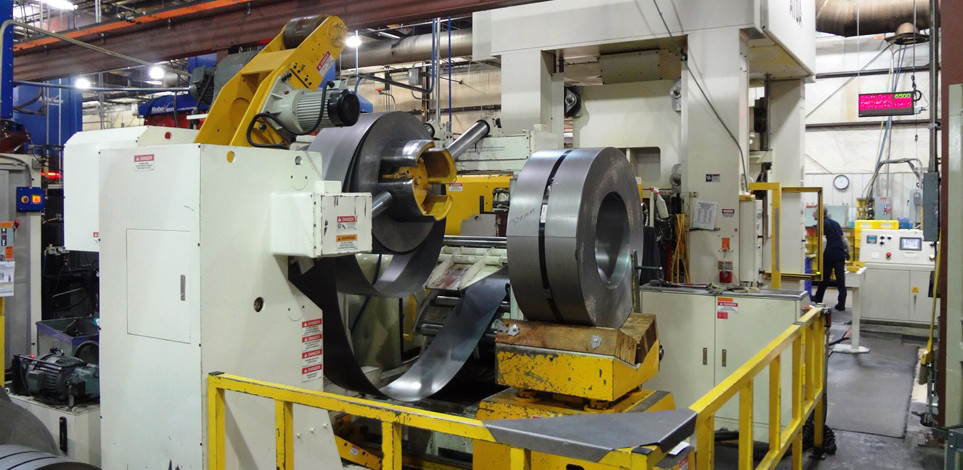In any manufacturing process there are numerous issues that can affect the operations. Here we outline some of the issues that can occur when uncoiling, straightening and feeding coil stock to the press and what can be done to avoid unnecessary problems.
Material Guiding
Coil stock handling and feeding equipment cannot “feel” and “compensate” for misguided material the way a person can in a hand fed operation. Alignment of coil handling equipment to each other and to the dies is critical to a smooth material flow. To accomplish this, coil handling equipment relies upon a series of edge guides to maintain the material within workable bounds. These are guides, not barriers — they are not a substitute for proper alignment of the equipment. Overworked guides result in damage to themselves or the material. Even if they can withstand the effects of misalignment, the resultant condition of the material and damage to the equipment will decrease operation productivity.
Dies
Dies equipped for hand feeding seldom accept coil stock without some modification. The tooling must address the intricacies associated with guiding the material as well as accommodate the mill tolerances and material conditions inherent in coil. Provisions must be made within or between the die and related equipment to avoid buckling and sagging of the automatically-fed material. Provisions to accept tolerance camber or crown in the stock must also be made within the die. Progressive dies also need to be equipped with suitable pilots to eliminate progression error.
Slick Material Finishes
Any number of surface conditions can produce a slick finish, which severely inhibits the ability to feed coil stock accurately. Proper selection of feeding equipment suited to work with slick material finishes, and die designs with tolerances that compensate for these conditions will improve production. Galvanized material also warrants special attention. As a guideline, the coil steel should be lubricated after the feeding device.
Sensitive or Critical Surface Finishes
Many materials have surfaces particularly susceptible to marking or distortion. Pre-painted, polished, and non-ferrous metals are all considered sensitive materials. Other materials can be so critical in appearance that even a normal or tough surface has to be processed with special care. Provisions can be made in the coil handling equipment as well as in the dies to accommodate these issues. Attention must be given to properly finish rolls and grippers for special material protection, to avoid touching materials with control devices, or to grip in non-critical areas.
Stop Marks
When material is stopped between rolls –particularly staggered rolls in a straightener — a series of straight lines can be “imprinted” across the surface. These are called “stop marks”, “set marks”, or “witness marks”, and often show up after a subsequent process such as painting or plating makes them noticeable. If a pull-through straightener is used, material will stop in the straightener with every stroke, causing marks throughout the run, which directly correspond to roll spacing and feed length. Power straighteners can be adjusted to minimize stopping or be equipped with a “creep” speed for nearly continuous running if stop marks are a critical factor.
Tough Materials
Almost all coil handling equipment is rated in terms of its capacity to process mild steel. So, calculations must be made to determine equipment capacity for materials tougher than mild steel. This is particularly critical to the straightening function where the rating of mild steel is considered under 50,000 PSI in yield strength. High carbon steel, stainless steel, and special alloys are among the materials for which caution must be exercised. Knowing material yield strength is necessary for proper application of coil processing equipment, as well as the knowing material shear strength for any cut-off process.
Production Rates
It’s important to not interpret coil feeding equipment speed rates as production rates of a press or cutoff process. Catalog listings are charted in general terms to cover a wide range of applications. Coil handling and feeding is an intermittent operation employing several coordinated machines. Material is fed to length, the feed waits for the press or shear to cycle, the feeding area is cleared, and then the feed delivers the next length. During the feed cycle there is acceleration, feed time, deceleration, stop time and often dwell times involved. Production rates depend on many variables beside the top speed of the coil feeding equipment. The cycle time of the press or shear needs to be considered, along with cycle time that is available for feeding. Individual feed lengths, the cross-section of material, the amount of work being done, the amount of slack material, and the capabilities of all the related machinery have to be known to establish true production rates.
Slack Material
Coil handling and feeding consists of a group of functions which range from intermittent to continuous or relatively continuous operation. To synchronize these functions it is typically necessary to accumulate slack material at some point in the process, and there are various methods to accomplish this. This concern is one of the most critical, and it must be addressed to properly specify the coil processing equipment for a given application. Variables such as material type, material thickness, yield strength, passline above floor, depth of looping pit, distance between machines, and targeted production rates must all be defined to assure the correct equipment is specified for the line.
